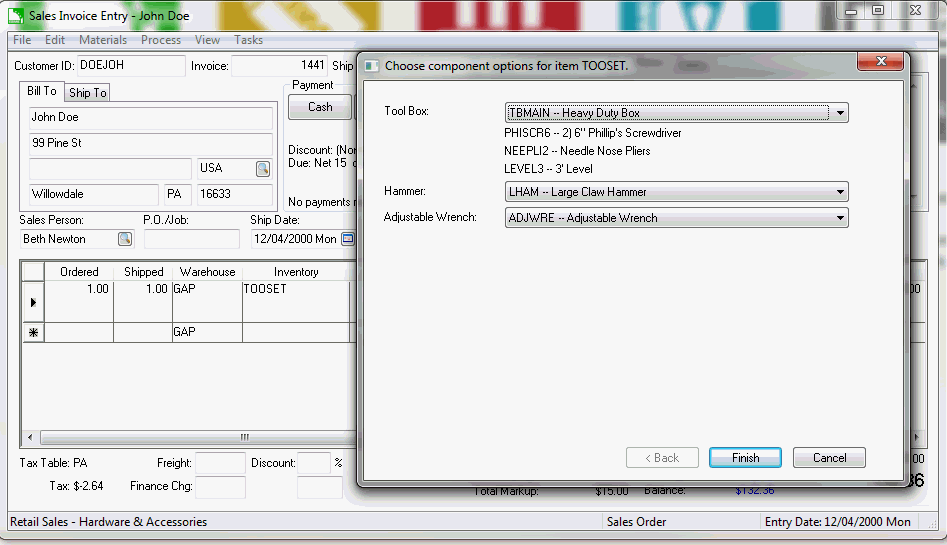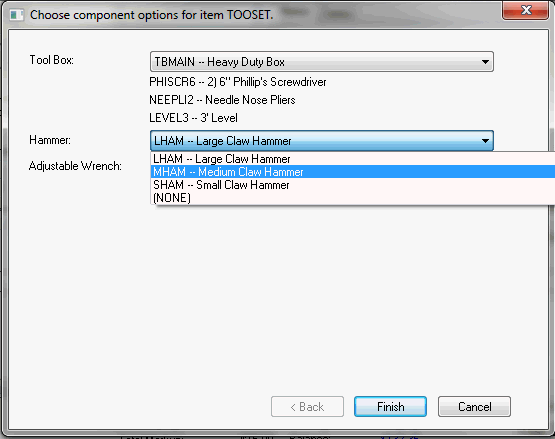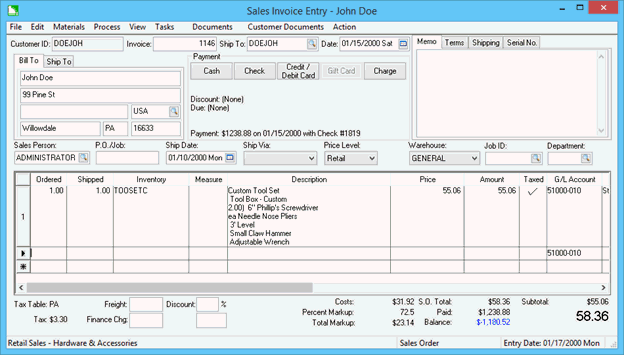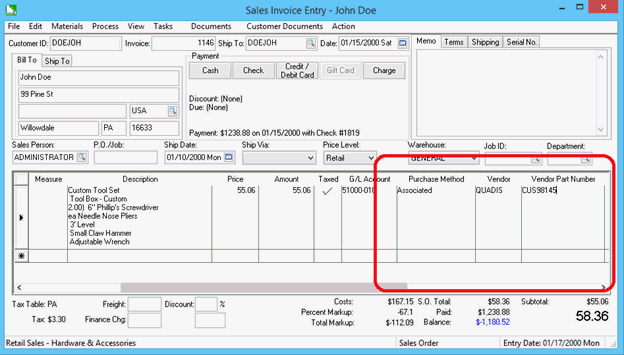- EBMS Knowledge Base
- Inventory
- Configure-to-Order Kitting
-
Client Resources
-
EBMS Main Documentation
- Introduction
- Getting Started
- Getting Started | Initial Installation
- Getting Started | Company Setup
- Quick User Guide | Financial Staff | Accountant
- Quick User Guide | Financial Staff | Accountant | Accountants Journal
- Quick User Guide | Sales Staff
- Quick User Guide | General Staff
- Features
- Reports
- Security
- Server Manager
- Technical
- Technical | Data Import and Export Utility
- Technical | SQL Mirror
- Automotive
- Automotive | Parts Catalog
- Automotive | Pricing
- Automotive | Point of Sale
- Automotive | Product Application
- Automotive | Keystone Interface
- Metal Supply
- Fuel Sales
- Horticulture
- Horticulture | Farm Setup
- Horticulture | Processing Payroll
- Horticulture | Managing the Farm
-
Sales
- Introduction
- Customers
- Customers | Miscellaneous Customers
- Proposals
- Proposals | Processing Proposals
- Proposals | Sets and Templates
- MyProposals
- MyOrders
- Sales Orders
- Invoices
- Materials Lists
- Sales and Use Tax
- Sales and Use Tax | TaxJar
- CRM
- CRM | Auto Send
- Recurring Billing
- Credits
- Customer Payments
- Payment Card Processing
- Payment Card Processing | Gift Cards
- Payment Card Processing | Loyalty Cards
- Payment Card Processing | Verifone Gateway
- Freight and Shipping Tools
- General Ledger Transactions
- Point of Sale
- Point of Sale | Point of Sale Hardware
- Point of Sale | Xpress POS System
- Point of Sale | Advanced Tools
- Signature Capture
- Salesperson Commissions
-
Inventory
- Product Catalog
- Product Catalog | Using Product Codes for No Count Items
- Product Pricing
- Product Pricing | Special Pricing
- Tracking Counts
- Unit of Measure
- Purchasing
- Special Orders and Drop Shipped Items
- Receiving Product
- Barcodes
- MyInventory and Scanner
- Components (BOM) and Accessories
- Components (BOM) and Accessories | Component Formula Tool
- Made-to-Order Kitting
- Configure-to-Order Kitting
- Multiple Inventory Locations
- Multiple Inventory Locations | Creating Locations
- Multiple Inventory Locations | Using Multiple Locations
- Multiple Inventory Locations | Product Catalog Sync
- Multi-Vendor Catalog
- Serialized Items
- Serialized Items | Purchasing or Manufacturing an Item
- Serialized Items | Selling and/or Associating an item with a customer
- Lots
- Product Attributes
- Product Attributes | Selling and Purchasing Items with Attributes
- Product Attributes | Custom Attributes
- Mobile Scanner (Legacy)
-
Labor
- Getting Started
- Workers
- Taxes and Deductions
- Work Codes
- Time and Attendance
- Time and Attendance | Time Track App
- Processing Payroll
- Closing the Payroll Year
- Processing Payroll - Advanced
- Salaried Pay
- Piecework Pay
- Direct Deposit
- 3rd Party Payroll Service
- Subcontract Workers
- Flag Pay
- Prevailing Wages
- MyDispatch
- MyTasks
- MyTime
- MyTime | Communications
- MyTime | Setup
- Tasks
- Tasks | Getting Started
- Tasks | Creating Tasks
- Tasks | Scheduling Tasks
- Tasks | Customizing Task Views
- Tasks | Managing Tasks
-
Financials
- Introduction
- Fiscal Year
- Chart of Accounts
- Budget
- Financial Reporting
- Transactions and Journals
- Transactions and Journals | Journals
- Account Reconciliation
- 1099
- Departments and Profit Centers
- Fund Accounts
- Bank Accounts
- Bank Feed
- Vendors
- Vendors | Miscellaneous Vendors
- Purchase Orders
- Expense Invoices
- Vendor Payments
- AP Transactions
- Landed Cost
- Fixed Assets and Depreciation
- Fixed Assets and Depreciation | Fixed Assets
- Fixed Assets and Depreciation | Fixed Assets | Adding Assets
- Fixed Assets and Depreciation | Processing Depreciation
- Fixed Assets and Depreciation | Disposing Assets
- MyJobs
-
E-commerce
-
Rental
-
Job Costing
-
Manufacturing
Selling a CTO Item
A Configure-To-Order item (CTO) is entered within a quote or sales order at the time the customer identifies the options that are desired for the sale. The difference between a CTO and a regular inventory item is that the CTO item consists of customizations or variations that are configured by selecting the desired optional components within the sales order or quote.
Complete the following steps to configure a PO item within a sales order:
Open a new or existing sales order by selecting Sales > Sales Invoices and SOs from the main EBMS menu. Review Sales Orders > Entering a Sales Order section within the sales documentation for more information to supplement the following instructions.
Enter an Inventory ID in the details line to open the optional component dialog as shown below:

Note that at least one component within the CTO item must be set as Component with Options for this dialog to open. All Configure-To-Order items should have at least one component that is configured with options. Review the Components and Accessories > Optional Components or Accessories section for more details on configuring optional components.Click on each drop down and select the desired optional component and select Finish.

The optional component descriptions will be appended to the CTO item description as shown below. Review the kitting settings within the Overview of the CTO Process section if the combination of descriptions does not appear. The pricing and cost may also be affected based on the configuration of the CTO item and the pricing and cost settings within the optional components. Review the Components and Accessories > Option and Kit Pricing section for more details on the pricing setup.

Configure the special order settings located to the right of the main sales order detail lines as shown below:

The Purchase Method should default Associated based on the option selected from the inventory item > Count tab. All CTO items should have a method setting of Associated to copy the description and cost from the sales order detail line to the purchase order.
Set the optional Vendor setting to identify source vendor used within the purchase order. This setting will default. This setting can be set at the time of the purchase if the Inventory > Purchasing Page is used to process the special order CTO items.
The Vendor Part Number will default to the vendor Part Number identified within the Purchasing tab of the inventory item. Add or update this optional part number to copy to the purchase order and record on the inventory item for future reference.
Select Process > Create Purchase Order from the sales order menu to copy information to a purchase order. Review the following Purchasing a CTO Item section for more details and options on the CTO process.
